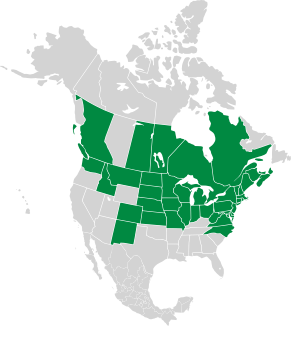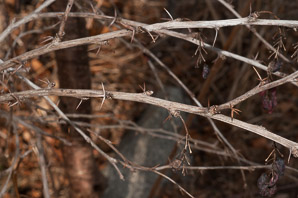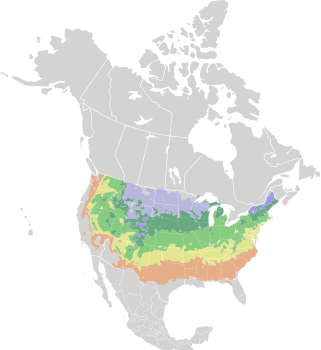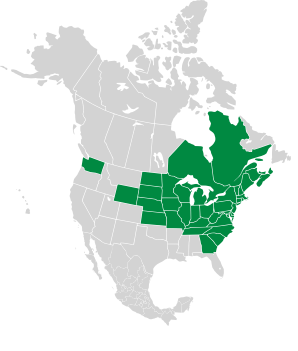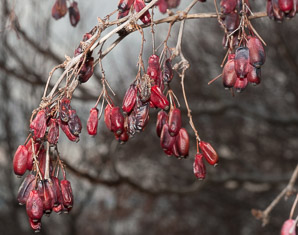
|
Berberis vulgaris L. Common barberry, barberry, berbery, European barberry, jaundice-berry, pipperidge bush
The shrub is native to central and southern Europe, northwest Africa and western Asia. It has become naturalised in northern Europe, including the British Isles and Scandinavia, and North America. Both this species and Japanese barberry, a Japanese relative, were imported, used as ornamental shrubs and, because of their thorns, natural fences. Both escaped cultivation, but the Japanese variety is aggressive and often considered invasive. Identification: Shrubs are 3-9½′ (1-3 m) in height, with grooved stems. Leaves are oval, ¾-1¾″ (2-5 cm) × ⅜-¾″ (1-2 cm), finely toothed, in clusters that include a spine ⅛-¼″ (3-8 mm) long and 2-5 leaves. Flowers are yellow, ⅛-3/16″ (4-6 mm) across, in panicles 1-2″ (3-6 cm) long. Berries are bright red, with a distinctive oval shape, ¼-⅜″ (7-10 mm) long and 1/16-3/16″ (3-5 mm) in diameter, hanging in tight clusters. Edibility: Berries are very sour, and hard to harvest because of the spines, but, when combined with sugar, may be used to create a deep ruby red jelly traditionally used to accompany meat dishes. The berries have natural pectin, which causes the boiled mixture to gel; they are also rich in vitamin C. They are best harvested after a freeze. Japanese barberry, more common in most places, has similar-appearing berries that do not make good jelly. Leaves and root bark of both species are mildly poisonous, principally due to berberine. Below is a comparison of two common species of barberry: |
10/7/2012 · Beaver Brook Assn Conservation Lands, Hollis, New Hampshire · ≈ 12 × 8″ (31 × 20 cm) 2/14/2012 · Halibut Point State Park, Rockport, Massachusetts · ≈ 9 × 6″ (22 × 14 cm) 2/14/2012 · Halibut Point State Park, Rockport, Massachusetts · ≈ 3 × 4½″ (7.9 × 11 cm) |
||||||||||||||||||||||||||||
|
| |||||||||||||||||||||||||||||
Berberis koreana |
Berberis thunbergii |
You are here Berberis vulgaris |
|||||||||||||||||||||||||||
|---|---|---|---|---|---|---|---|---|---|---|---|---|---|---|---|---|---|---|---|---|---|---|---|---|---|---|---|---|---|
| Common Name |  |
 |
 |
||||||||||||||||||||||||||
| Plant | 3-6′ (91-182 cm) high. Stems are woody and grooved. There are ¼″ (6.3 mm) thorns along the branches, which arch and overlap each other. | 3-9½′ (1-3 m) in height, with grooved stems. There are ¼″ (6.3 mm) thorns along the branches. | |||||||||||||||||||||||||||
| Flowers | ¼″ (6.3 mm) around and yellow, distributed along branches. | Yellow, ⅛-3/16″ (4-6 mm) across, in panicles 1-2″ (3-6 cm) long. | |||||||||||||||||||||||||||
| Leaves | Bright green and spatula-shaped, much wider at the ends, about ¾″ (1.9 cm) long and ¼″ (6.3 mm) wide. In the fall, the leaves turn orange, deep red, or purple in color. | Oval, ¾-1¾″ (2-5 cm) × ⅜-¾″ (1-2 cm), finely toothed, in clusters that include a spine ⅛-¼″ (3-8 mm) long and 2-5 leaves. | |||||||||||||||||||||||||||
| Fruit | Berries are bright red, with a distinctive oval shape, ¼-⅜″ (7-10 mm) long and 1/16-3/16″ (3-5 mm) in diameter, distributed fairly evenly along branches. | Berries are bright red, with a distinctive oval shape, ¼-⅜″ (7-10 mm) long and 1/16-3/16″ (3-5 mm) in diameter, hanging in tight clusters. | |||||||||||||||||||||||||||
| Range/ Zones |
|
|
|
||||||||||||||||||||||||||
| Type | Wild | Wild | Wild | ||||||||||||||||||||||||||
| Occurrence | Common to invasive | Fairly common | |||||||||||||||||||||||||||
Online References:
Berberis vulgaris description by Thomas H. Kent, last updated 16 Sep 2020.
© FloraFinder.org. All rights reserved.
2/14/2012 · Halibut Point State Park, Rockport, Massachusetts · ≈ 7 × 4½″ (17 × 11 cm) ![]() ID is uncertain
ID is uncertain 
Range:
